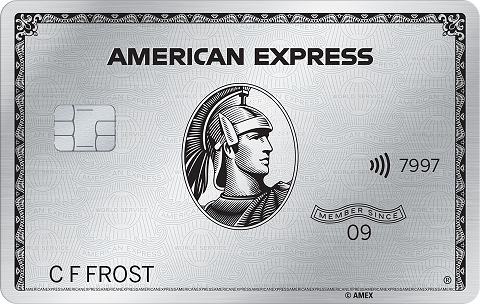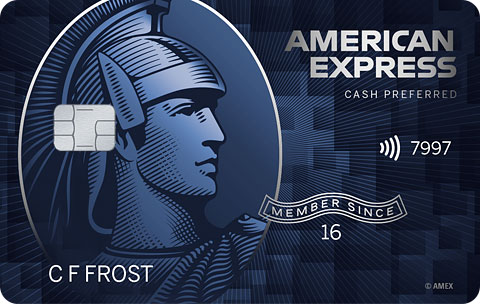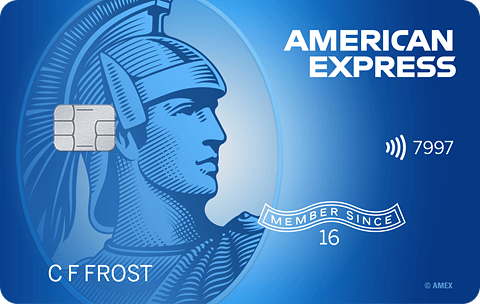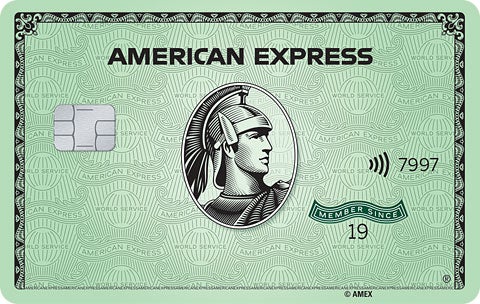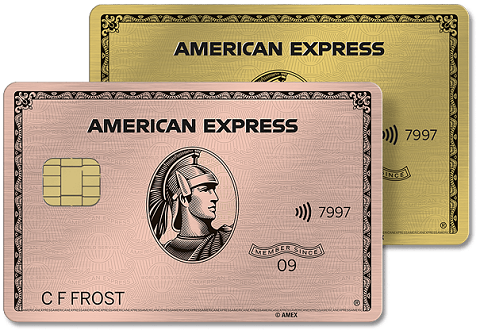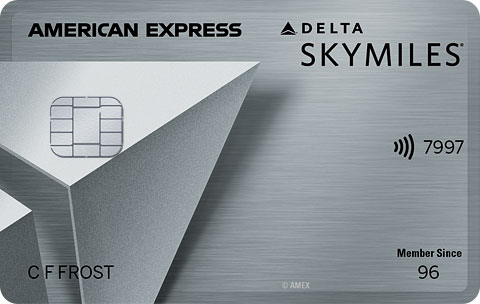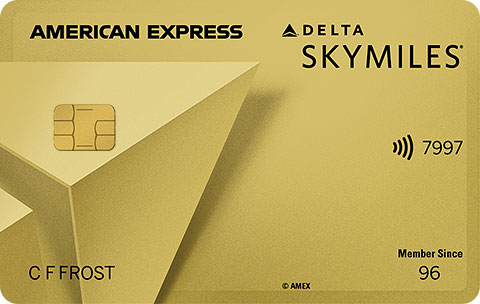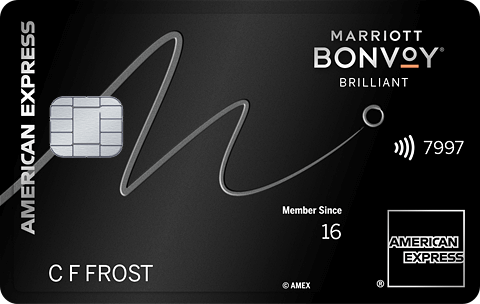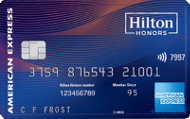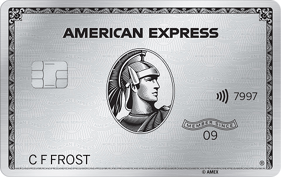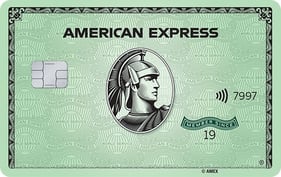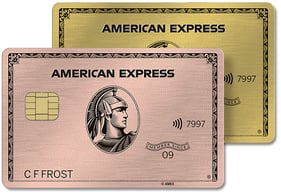American Express -- Amex for short -- is often ranked at the top of any list of top credit card companies, offering high-rated customer service, a great user experience, and a highly rated mobile app that helps manage your credit card needs on the go.
Best American Express credit cards
- Travel rewards and airport lounges: The Platinum Card® from American Express
- Cash back at U.S. supermarkets: Blue Cash Preferred® Card from American Express
- U.S. gas stations and U.S. supermarkets: Blue Cash Everyday® Card from American Express
- Dining, travel, and transit: American Express® Green Card
- Restaurants and U.S. supermarkets: American Express® Gold Card
- Regular Delta flyers: Delta SkyMiles® Platinum American Express Card
- Casual Delta flyers: Delta SkyMiles® Gold American Express Card
- Marriott hotel stays: Marriott Bonvoy Brilliant® American Express® Card
- Frequent Hilton guests: Hilton Honors American Express Aspire Card
The Platinum Card® from American Express
Great for: Travel rewards and airport lounges
On American Express' Secure Website.
Terms apply
On American Express' Secure Website.
Terms apply
Good/Excellent (670-850)
Intro APR
Purchases: n/a
Balance Transfers: n/a
Regular APR
See Pay Over Time APR
Rewards Earn 5X Membership Rewards® Points for flights booked directly with airlines or with American Express Travel up to $500,000 on these purchases per calendar year and earn 5X Membership Rewards® Points on prepaid hotels booked with American Express Travel. Earn 1X Membership Rewards® Points on other purchases. Terms and limitations apply.
1X-5X Membership Rewards® Points
Annual Fee
$695
Welcome Offer Earn 80,000 Membership Rewards® Points after you spend $8,000 on purchases on your new Card in your first 6 months of Card Membership.
80,000
-
This luxury travel card has some of the most prestigious perks you'll find — access to over 1,400 airport lounges, elite status with Hilton and Marriott Bonvoy, and spending credits worth over $1,500 in value every year. Just be ready for the hefty annual fee, which can be offset in the first year with a welcome bonus worth $800 in points. Terms apply. Read Full Review
-
- Big welcome offer
- Substantial spending credits
- Airport lounge access
- Hotel benefits
- Flexible travel points
- Annual fee
- Limited bonus categories
- Spending credits can be complicated to manage
-
- Earn 80,000 Membership Rewards® Points after you spend $8,000 on purchases on your new Card in your first 6 months of Card Membership. Apply and select your preferred metal Card design: classic Platinum Card®, Platinum x Kehinde Wiley, or Platinum x Julie Mehretu.
- Earn 5X Membership Rewards® Points for flights booked directly with airlines or with American Express Travel up to $500,000 on these purchases per calendar year and earn 5X Membership Rewards® Points on prepaid hotels booked with American Express Travel.
- $200 Hotel Credit: Get up to $200 back in statement credits each year on prepaid Fine Hotels + Resorts® or The Hotel Collection bookings with American Express Travel when you pay with your Platinum Card®. The Hotel Collection requires a minimum two-night stay.
- $240 Digital Entertainment Credit: Get up to $20 back in statement credits each month on eligible purchases made with your Platinum Card® on one or more of the following: Disney+, a Disney Bundle, ESPN+, Hulu, The New York Times, Peacock, and The Wall Street Journal. Enrollment required.
- $155 Walmart+ Credit: Cover the cost of a $12.95 monthly Walmart+ membership (subject to auto-renewal) with a statement credit after you pay for Walmart+ each month with your Platinum Card®. Cost includes $12.95 plus applicable local sales tax. Plus Up Benefits are excluded.
- $200 Airline Fee Credit: Select one qualifying airline and then receive up to $200 in statement credits per calendar year when incidental fees are charged by the airline to your Platinum Card®.
- $200 Uber Cash: Enjoy Uber VIP status and up to $200 in Uber savings on rides or eats orders in the US annually. Uber Cash and Uber VIP status is available to Basic Card Member only. Terms Apply.
- $300 Equinox Credit: Get up to $300 back in statement credits per calendar year on an Equinox membership, or an Equinox club membership (subject to auto-renewal) when you pay with your Platinum Card®. Enrollment required. Visit https://platinum.equinox.com/ to enroll.
- $189 CLEAR® Plus Credit: Breeze through security with CLEAR Plus at 100+ airports, stadiums, and entertainment venues nationwide and get up to $189 back per calendar year on your Membership (subject to auto-renewal) when you use your Platinum Card®. Learn more.
- $100 Global Entry Credit: Receive either a $100 statement credit every 4 years for a Global Entry application fee or a statement credit up to $85 every 4.5 years for a TSA PreCheck® (through a TSA official enrollment provider) application fee, when charged to your Platinum Card®. Card Members approved for Global Entry will also receive access to TSA PreCheck at no additional cost.
- Shop Saks with Platinum: Get up to $100 in statement credits annually for purchases in Saks Fifth Avenue stores or at saks.com on your Platinum Card®. That's up to $50 in statement credits semi-annually. Enrollment required.
- $300 SoulCycle At-Home Bike Credit: Get a $300 statement credit for the purchase of a SoulCycle at-home bike with your Platinum Card®. An Equinox+ subscription is required to purchase a SoulCycle at-home bike and access SoulCycle content. Must charge full price of bike in one transaction. Shipping available in the contiguous U.S. only. Enrollment Required.
- Unlock access to exclusive reservations and special dining experiences with Global Dining Access by Resy when you add your Platinum Card® to your Resy profile.
- $695 annual fee.
- Terms Apply.
Blue Cash Preferred® Card from American Express
Great for: Cash back at U.S. supermarkets
On American Express' Secure Website.
Terms apply
On American Express' Secure Website.
Terms apply
Good/Excellent (670-850)
Intro APR
Purchases: 0%, 12 months
Balance Transfers: 0%, 12 months
Regular APR
19.24%-29.99% Variable
Rewards 6% Cash Back at U.S. supermarkets on up to $6,000 per year in purchases (then 1%). 6% Cash Back on select U.S. streaming subscriptions. 3% Cash Back at U.S. gas stations. 3% Cash Back on transit (including taxis/rideshare, parking, tolls, trains, buses and more). 1% Cash Back on other purchases. Cash Back is received in the form of Reward Dollars that can be redeemed as a statement credit or at Amazon.com checkout.
1%-6% Cash Back
Annual Fee
$0 intro annual fee for the first year, then $95.
Welcome Offer Earn a $250 statement credit after you spend $3,000 in purchases on your new Card within the first 6 months.
$250
-
This card offers market-leading cash back at U.S. Supermarkets. The welcome bonus and intro APR offer just sweeten the deal. Terms apply. If you spend at least $500 per month on groceries (excluding wholesale clubs and super-stores like Costco and Walmart), this card is worth considering. Read Full Review
-
- Big welcome offer
- U.S. supermarkets rewards
- U.S. gas stations rewards
- Streaming subscription rewards
- Travel and purchase protections
- Annual fee
- Foreign transaction fee
-
- Earn a $250 statement credit after you spend $3,000 in purchases on your new Card within the first 6 months.
- $0 intro annual fee for the first year, then $95.
- Buy Now, Pay Later: Enjoy $0 intro plan fees when you use Plan It® to split up large purchases into monthly installments. Pay $0 intro plan fees on plans created during the first 12 months from the date of account opening. Plans created after that will have a monthly plan fee up to 1.33% of each eligible purchase amount moved into a plan based on the plan duration, the APR that would otherwise apply to the purchase, and other factors.
- Low Intro APR: 0% on purchases and balance transfers for 12 months from the date of account opening. After that, your APR will be a variable APR of 19.24% - 29.99%. Variable APRs will not exceed 29.99%.
- 6% Cash Back at U.S. supermarkets on up to $6,000 per year in purchases (then 1%).
- 6% Cash Back on select U.S. streaming subscriptions.
- 3% Cash Back at U.S. gas stations.
- 3% Cash Back on transit (including taxis/rideshare, parking, tolls, trains, buses and more).
- 1% Cash Back on other purchases.
- Cash Back is received in the form of Reward Dollars that can be redeemed as a statement credit or at Amazon.com checkout.
- Get up to $120 in statement credits annually when you pay for an auto-renewing subscription to Equinox+ at equinoxplus.com with your Blue Cash Preferred® Card. That’s $10 in statement credits each month. Enrollment required.
- Thinking about getting the Disney Bundle which can include Disney+, Hulu, and ESPN+? Your decision made easy with $7/month back in the form of a statement credit after you spend $9.99 or more each month on an eligible subscription (subject to auto renewal) with your Blue Cash Preferred® Card. Enrollment required.
- Terms Apply.
Blue Cash Everyday® Card from American Express
Great for: U.S. gas stations and U.S. supermarkets
On American Express' Secure Website.
Terms apply
On American Express' Secure Website.
Terms apply
Good/Excellent (670-850)
Intro APR
Purchases: 0%, 15 months
Balance Transfers: 0%, 15 months
Regular APR
19.24%-29.99% Variable
Rewards 3% Cash Back at U.S. supermarkets on up to $6,000 per year in purchases, then 1%. 3% Cash Back on U.S. online retail purchases, on up to $6,000 per year, then 1%. 3% Cash Back at U.S. gas stations, on up to $6,000 per year, then 1%. Cash Back is received in the form of Reward Dollars that can be redeemed as a statement credit or at Amazon.com checkout.
1%-3% cash back
Annual Fee
$0
Welcome Offer Earn a $200 statement credit after you spend $2,000 in purchases on your new Card within the first 6 months.
$200
-
If gas and groceries are big line items in your budget, don't miss this card. You won't pay an annual fee, and you can earn a generous 3% cash back at supermarkets, online retail purchases, and gas stations in the U.S., on up to $6,000 per year, per category. A 0% APR intro offer lasting 15 months and a $200 welcome bonus for a $2,000 spend inside of 6 months (terms apply) round out the perks on this Amex. Read Full Review
-
- U.S. supermarkets and online retail rewards
- U.S. gas stations cash back
- Big welcome offer
- No annual fee (see rates and fees)
- Foreign transaction fee
- High spend requirement for welcome offer
-
- Earn a $200 statement credit after you spend $2,000 in purchases on your new Card within the first 6 months.
- No Annual Fee.
- Balance Transfer is back! Enjoy 0% intro APR on purchases and balance transfers for 15 months from the date of account opening. After that, 19.24% to 29.99% variable APR.
- 3% Cash Back at U.S. supermarkets on up to $6,000 per year in purchases, then 1%.
- 3% Cash Back on U.S. online retail purchases, on up to $6,000 per year, then 1%.
- 3% Cash Back at U.S. gas stations, on up to $6,000 per year, then 1%.
- Cash Back is received in the form of Reward Dollars that can be redeemed as a statement credit or at Amazon.com checkout.
- Thinking about getting the Disney Bundle which can include Disney+, Hulu, and ESPN+? Your decision made easy with $7/month back in the form of a statement credit after you spend $9.99 or more each month on an eligible subscription (subject to auto renewal) with your Blue Cash Everyday® Card. Enrollment required.
- Enjoy up to $15 back per month when you purchase a Home Chef meal kit subscription (subject to auto renewal) with your enrolled Blue Cash Everyday® Card.
- Terms Apply.
American Express® Green Card
Great for: Dining, travel, and transit
Good/Excellent (670-850)
Intro APR
Purchases: n/a
Balance Transfers: n/a
Regular APR
See Pay Over Time APR
Rewards 3X Membership Rewards® Points on Restaurants worldwide, including takeout and delivery. 3X Membership Rewards® points on all eligible travel, from subway swipes and window seats to hotel stays and city tours. The 1x points on other purchases.
1x - 3x points
Annual Fee
$150
Welcome Offer Earn 40,000 Membership Rewards® Points after you spend $3,000 in eligible purchases on your American Express® Green Card within the first 6 months of Card Membership.
40,000 Membership Rewards® Points
-
Packs in a big welcome offer, lucrative credits, and premium points for travel and restaurants. These perks justify the annual fee for many new cardholders.
-
- Restaurant rewards
- Travel and transit rewards
- Welcome offer
- Useful travel points
- Travel credits
- Annual fee
-
- Earn 40,000 Membership Rewards® Points after you spend $3,000 in eligible purchases on your American Express® Green Card within the first 6 months of Card Membership.
- Earn 3X Membership Rewards® points on travel including airfare, hotels, cruises, tours, car rentals, campgrounds, and vacation rentals.
- Earn 3X Membership Rewards® Points on transit purchases including trains, taxicabs, rideshare services, ferries, tolls, parking, buses, and subways.
- Earn 3X Membership Rewards® points on eligible purchases at restaurants worldwide, including takeout and delivery in the US.
- $189 CLEAR Plus Credit: Receive up to $189 per calendar year in statement credits when you pay for your CLEAR Plus membership (subject to auto-renewal) with the American Express® Green Card.
- $100 LoungeBuddy: No airport lounge membership? No problem! Purchase lounge access through the LoungeBuddy app using the American Express® Green Card and receive up to $100 in statement credits annually.
- Payment Flexibility: When it comes to paying your bill, you have options. You can always pay in full. You also have the flexibility to carry a balance with interest or use Plan It® to split up large purchases into monthly payments with a fixed fee, up to your Pay Over Time Limit. You may be able to keep spending beyond your limit – you’ll just need to pay for any new purchases in full when your bill is due.
- Trip Delay Insurance: If a round-trip is paid for entirely with your Eligible Card and a covered reason delays your trip more than 12 hours, Trip Delay Insurance can help reimburse certain additional expenses purchased on the same Eligible Card, up to $300 per trip, maximum 2 claims per eligible account per 12 consecutive month period. Terms, conditions and limitations apply. Coverage is provided by New Hampshire Insurance Company, an AIG Company.
- No Foreign Transaction Fees: No matter where you’re traveling, when you use your American Express® Green Card there are no foreign transaction fees.
- $150 annual fee.
- Terms Apply.
Great for: Restaurants and U.S. supermarkets
Good/Excellent (670-850)
Intro APR
Purchases: n/a
Balance Transfers: n/a
Regular APR
See Pay Over Time APR
Rewards Earn 4X Membership Rewards® Points at Restaurants, plus takeout and delivery in the U.S., and earn 4X Membership Rewards® points at U.S. supermarkets (on up to $25,000 per calendar year in purchases, then 1X). Earn 3X Membership Rewards® points on flights booked directly with airlines or on amextravel.com.
1X-4X Membership Rewards® Points
Annual Fee
$250
Welcome Offer Earn 60,000 Membership Rewards® Points after you spend $6,000 on eligible purchases with your new Card within the first 6 months of Card Membership.
60,000
-
This card offers considerable value, as it earns 4X points at U.S. supermarkets (on up to $25,000 per calendar year in purchases, then 1X) and 4X points at restaurants. Plus, earn 3X points on flights booked directly with airlines or on American Express Travel. Meanwhile, $120 in annual dining credits and $120 in Uber cash can offset almost the entire $250 annual fee. (Terms apply.) Overall, it’s an incredibly lucrative card for those who spend a lot in those categories. Read Full Review
-
- Impressive welcome offer
- Restaurant rewards
- U.S. supermarket rewards
- Travel and dining credits
- High-value rewards points
- Annual fee
- Inflexible spending credits
-
- Earn 60,000 Membership Rewards® points after you spend $6,000 on eligible purchases with your new Card within the first 6 months of Card Membership.
- Earn 4X Membership Rewards® Points at Restaurants, plus takeout and delivery in the U.S., and earn 4X Membership Rewards® points at U.S. supermarkets (on up to $25,000 per calendar year in purchases, then 1X).
- Earn 3X Membership Rewards® points on flights booked directly with airlines or on amextravel.com.
- $120 Uber Cash on Gold: Add your Gold Card to your Uber account and each month automatically get $10 in Uber Cash for Uber Eats orders or Uber rides in the U.S., totaling up to $120 per year.
- $120 Dining Credit: Satisfy your cravings and earn up to $10 in statement credits monthly when you pay with the American Express® Gold Card at Grubhub, The Cheesecake Factory, Goldbelly, Wine.com, Milk Bar and select Shake Shack locations. Enrollment required.
- Get a $100 experience credit with a minimum two-night stay when you book The Hotel Collection through American Express Travel. Experience credit varies by property.
- Choose the color that suits your style. Gold or Rose Gold.
- No Foreign Transaction Fees.
- Annual Fee is $250.
- Terms Apply.
Delta SkyMiles® Platinum American Express Card
Great for: Regular Delta flyers
On American Express' Secure Website.
Terms apply
On American Express' Secure Website.
Terms apply
Good/Excellent (670-850)
Intro APR
Purchases: n/a
Balance Transfers: n/a
Regular APR
20.99%-29.99% Variable
Rewards Earn 3X Miles on Delta purchases and purchases made directly with hotels. Earn 2X Miles at restaurants worldwide including takeout and delivery in the U.S., and at U.S. supermarkets. Earn 1X Miles on all other eligible purchases.
1X-3X Miles
Annual Fee
$350
Welcome Offer Earn 50,000 Bonus Miles after you spend $3,000 in purchases on your new Card in your first 6 months of Card Membership
50,000 Bonus Miles
-
The welcome offer, bonus miles categories, and Delta perks make this card's annual fee worth it if you fly on the carrier regularly. Read Full Review
-
- Welcome offer
- Free checked bag
- Companion certificate
- Travel credit
- Annual fee
- No complimentary airport lounge access
-
- Earn 50,000 Bonus Miles after you spend $3,000 in purchases on your new Card in your first 6 months of Card Membership.
- Receive a Companion Certificate on Main Cabin domestic, Caribbean, or Central American roundtrip flights each year after renewal of your Card. The Companion Ticket requires payment of government-imposed taxes and fees of no more than $80 for roundtrip domestic flights and no more than $250 for roundtrip international flights (both for itineraries with up to four flight segments). Baggage charges and other restrictions apply. See terms and conditions for details.
- Receive $2,500 Medallion® Qualification Dollars each Medallion Qualification Year and get closer to Status with MQD Headstart.
- Delta SkyMiles® Platinum American Express Card Members get 15% off when using miles to book Award Travel on Delta flights through delta.com and the Fly Delta app. Discount not applicable to partner-operated flights or to taxes and fees.
- Earn $1 Medallion® Qualification Dollar for each $20 of purchases made on your Delta SkyMiles® Platinum American Express Card in a calendar year and get a boost toward achieving Medallion Status for next Medallion Year.
- Earn 3X Miles on Delta purchases and purchases made directly with hotels.
- Earn 2X Miles at restaurants worldwide including takeout and delivery in the U.S., and at U.S. supermarkets and earn 1X Miles on all other eligible purchases.
- $120 Resy Credit: With the Delta SkyMiles® Platinum American Express Card Resy Credit, earn up to $10 per month in statement credits on eligible Resy purchases using your enrolled Card.
- $120 Rideshare Credit: You can earn up to $10 back in statement credits each month on U.S. rideshare purchases with select providers after you pay with your Delta SkyMiles® Platinum American Express Card. Enrollment Required.
- Enjoy your first checked bag free on Delta flights.
- Receive Main Cabin 1 Priority Boarding on Delta flights; board early, stow your carry-on bag and settle in sooner.
- Fee Credit for Global Entry or TSA PreCheck®: Receive $100 back for Global Entry or up to $85 back for TSA PreCheck® after you apply through any Official Enrollment Provider. If approved for Global Entry, at no additional charge, you will receive access to TSA PreCheck.
- Delta SkyMiles® Platinum American Express Card Members with an eligible ticket will be added to the Complimentary Upgrade list, after Delta SkyMiles Medallion Members and Reserve Card Members.
- No Foreign Transaction Fees.
- $350 Annual Fee.
- Terms Apply.
Delta SkyMiles® Gold American Express Card
Great for: Casual Delta flyers
On American Express' Secure Website.
Terms apply
On American Express' Secure Website.
Terms apply
Good/Excellent (670-850)
Intro APR
Purchases: n/a
Balance Transfers: n/a
Regular APR
20.99%-29.99% Variable
Rewards Earn 2X Miles on Delta purchases, at U.S. Supermarkets and at restaurants worldwide, including takeout and delivery in the U.S. Earn 1X Mile on all other eligible purchases.
1X-2X Miles
Annual Fee
$0 introductory annual fee for the first year, then $150.
Welcome Offer Earn 40,000 Bonus Miles after you spend $2,000 in purchases on your new Card in your first 6 months of Card Membership.
40,000 Bonus Miles
-
An excellent option for most Delta travelers, given the balance of a nice welcome offer, premium rewards program, and a low annual fee. Read Full Review
-
- Welcome offer
- Free checked bag
- Priority boarding
- Earn a Flight Credit
- Annual fee
- No premium travel benefits
-
- Earn 40,000 Bonus Miles after you spend $2,000 in purchases on your new Card in your first 6 months of Card Membership.
- Enjoy a $0 introductory Annual Fee for the first year, then $150.
- Delta SkyMiles® Gold American Express Card Members get 15% off when using miles to book Award Travel on Delta flights through delta.com and the Fly Delta app. Discount not applicable to partner-operated flights or to taxes and fees.
- $200 Delta Flight Credit: After you spend $10,000 in purchases in a year, you can receive a $200 Delta Flight Credit to use toward future travel.
- Earn 2X Miles on Delta purchases, at U.S. Supermarkets and at restaurants worldwide, including takeout and delivery in the U.S. Earn 1X Miles on all other eligible purchases.
- You can check your first bag free on Delta flights, saving up to $60 on a round-trip Delta flight per person. For a family of four that’s a potential savings of up to $240 per round-trip flight.
- Receive Main Cabin 1 Priority Boarding on Delta flights; board early, stow your carry-on bag and settle in sooner.
- $100 Delta Stays Credit: Delta SkyMiles® Gold American Express Card Members can earn up to $100 back annually on eligible prepaid Delta Stays bookings on delta.com.
- Take up to $50 off the cost of your flight for every 5,000 miles you redeem with Pay with Miles when you book on delta.com.
- Receive a 20% savings in the form of a statement credit on eligible Delta in-flight purchases after using your Card.
- No Foreign Transaction Fees.
- With Send & Split®, you can send money and split your Card purchases with any other Venmo or PayPal user, directly from the Amex App. Enroll today.
- Terms Apply.
Marriott Bonvoy Brilliant® American Express® Card
Great for: Marriott hotel stays
On American Express' Secure Website.
Terms apply
On American Express' Secure Website.
Terms apply
Good/Excellent (670-850)
Intro APR
Purchases: n/a
Balance Transfers: n/a
Regular APR
20.99%-29.99% Variable
Rewards Earn 6X Marriott Bonvoy points for each dollar of eligible purchases at hotels participating in Marriott Bonvoy®. 3X points at restaurants worldwide and on flights booked directly with airlines. 2X points on all other eligible purchases.
2X-6X points
Annual Fee
$650
Welcome Offer Earn 185,000 Marriott Bonvoy bonus points after you use your new Card to make $6,000 in purchases within the first 6 months of Card Membership.
185,000 Marriott Bonvoy bonus points
-
It's one of the most expensive hotel cards we've seen, but the benefits could be worth thousands for the right type of cardholder. Read Full Review
-
- Big Marriott Bonvoy bonuses
- Travel credits
- Free night award
- Automatic Gold Elite status
- Airport lounge access
- Expensive annual fee
-
- Earn 185,000 Marriott Bonvoy bonus points after you use your new Card to make $6,000 in purchases within the first 6 months of Card Membership.
- $300 Brilliant Dining Credit: Each calendar year, get up to $300 (up to $25 per month) in statement credits for eligible purchases made on the Marriott Bonvoy Brilliant® American Express® Card at restaurants worldwide.
- With Marriott Bonvoy Platinum Elite status, you can receive room upgrades, including enhanced views or suites, when available at select properties and booked with a Qualifying Rate.
- Earn 6X Marriott Bonvoy points for each dollar of eligible purchases at hotels participating in Marriott Bonvoy®. 3X points at restaurants worldwide and on flights booked directly with airlines. 2X points on all other eligible purchases.
- Free Night Award: Receive 1 Free Night Award every year after your Card renewal month. Award can be used for one night (redemption level at or under 85,000 Marriott Bonvoy points) at hotels participating in Marriott Bonvoy®. Certain hotels have resort fees.
- Each calendar year after spending $60,000 on eligible purchases on your Marriott Bonvoy Brilliant® American Express® Card, you will be eligible to select a Brilliant Earned Choice Award benefit. You can only earn one Earned Choice Award per calendar year. See https://www.choice-benefit.marriott.com/brilliant for Award options.
- $100 Marriott Bonvoy Property Credit: Enjoy your stay. Receive up to a $100 property credit for qualifying charges at The Ritz-Carlton® or St. Regis® when you book direct using a special rate for a two-night minimum stay using your Card.
- Fee Credit for Global Entry or TSA PreCheck®: Receive either a statement credit every 4 years after you apply for Global Entry ($100) or a statement credit every 4.5 years after you apply for a five-year membership for TSA PreCheck® (up to $85 through a TSA PreCheck official enrollment provider) and pay the application fee with your Marriott Bonvoy Brilliant® American Express® Card. If approved for Global Entry, at no additional charge, you will receive access to TSA PreCheck.
- Each calendar year with your Marriott Bonvoy Brilliant® American Express® Card you can receive 25 Elite Night Credits toward the next level of Marriott Bonvoy® Elite status. Limitations apply per Marriott Bonvoy member account. Benefit is not exclusive to Cards offered by American Express. Terms apply.
- Enroll in Priority Pass™ Select, which offers unlimited airport lounge visits to over 1,200 lounges in over 130 countries, regardless of which carrier or class you are flying. This allows you to relax before or between flights. You can enjoy snacks, drinks, and internet access in a quiet, comfortable location.
- No Foreign Transaction Fees on international purchases.
- With Cell Phone Protection, you can be reimbursed, the lesser of, your repair or replacement costs following damage, such as a cracked screen, or theft for a maximum of $800 per claim when your cell phone line is listed on a wireless bill and the prior month's wireless bill was paid by an Eligible Card Account. A $50 deductible will apply to each approved claim with a limit of 2 approved claims per 12-month period. Additional terms and conditions apply. Coverage is provided by New Hampshire Insurance Company, an AIG Company.
- $650 Annual Fee.
- Terms Apply.
Hilton Honors American Express Aspire Card
Great for: Frequent Hilton guests
Good/Excellent (670-850)
Intro APR
Purchases: N/A
Balance Transfers: N/A
Regular APR
20.99% to 29.99%, variable
Rewards 14 points per $1 at Hilton properties, 7 points per $1 on flights booked directly with the airline, rental cars booked through certain agencies, and dining in eligible U.S. restaurants, 3 points per $1 on all other eligible purchases
3X - 14x points
Annual Fee
$550
Welcome Offer 150,000 Hilton Honors points by spending $6,000 in the first six months of card opening
150,000 Hilton Honors points
-
This card comes with a high annual fee, but if you travel frequently and love to stay with Hilton, the benefits of the card can easily outweigh the fee.
-
- Big hotel rewards
- Generous travel credits
- Automatic Diamond status
- Annual free night award
- Airport lounge access
- Credits can be hard to use
-
- Earn 150,000 Hilton Honors points by spending $6,000 in the first six months of card opening.
- Earn 14 points per $1 spent at Hilton properties.
- Earn 7 points per $1 spent on flights booked directly with the airline, rental cars booked through certain agencies, and dining in eligible U.S. restaurants.
- Earn 3 points per $1 on all other eligible purchases.
- Earn up to $600 in statement credits.
- Complimentary airport lounge access
- Complimentary Diamond status
What is the best American Express credit card?
While the best credit cards for you will depend on what you need out of your card, there are a few American Express cards that hit the top of most rewards card lists.
First, The Platinum Card® from American Express is hands-down one of the best travel rewards cards, offering bonus rewards on hotel and airline purchases, as well as more than a dozen valuable travel perks like airport lounge access and Uber credits (select enrollment required, terms apply). Check out the benefits of The Platinum Card® from American Express.
Similarly, the Blue Cash Preferred® Card from American Express is one of the top cash back credit cards, offering bonus rewards in everyday categories that are hard to beat (terms apply).
Best Amex travel credit cards
Great for travel rewards and airport lounges: The Platinum Card® from American Express
The Platinum Card® from American Express is a truly top-of-the-line travel card packed full of perks, welcome offers, and statement credits. (Terms apply, select enrollment required, see rates and fees)
Read The Platinum Card® from American Express review
Great for dining, travel, and transit: American Express® Green Card
The American Express® Green Card is a mid-level travel rewards card that offers premium rewards on restaurant, transit, and travel purchases. While it's not as packed with perks as its more-expensive Platinum sibling, it does come with valuable statement credits. (All information about the American Express® Green Card has been gathered independently by The Ascent. Terms apply, select enrollment required, see rates and fees)
Read the full American Express® Green Card review
Great for restaurants and U.S. supermarkets: American Express® Gold Card
The American Express® Gold Card is a foodie's best friend with its premium rewards at restaurants. The hefty annual fee is offset by the lucrative credits, as well as the large welcome offer. (Terms apply, select enrollment required, see rates and fees)
Best Amex cash back cards
Great for cash back at U.S. supermarkets: Blue Cash Preferred® Card from American Express
The Blue Cash Preferred® Card from American Express is an ideal cash back rewards card for everyday purchases. You'll earn high-rate rewards on purchases from U.S. supermarkets and grocery stores, select streaming services, transit providers, and U.S. gas stations. Plus, the Blue Cash Preferred® Card from American Express comes with a competitive welcome offer and a 0% intro APR offer for 12 months on purchases and balance transfers. The go-to rate is 19.24%-29.99% Variable after the promotional period expires. (Terms apply, see rates and fees)
Read the full Amex Blue Cash Preferred review
Great for U.S. gas stations, U.S. supermarkets, and department stores: Blue Cash Everyday® Card from American Express
The Blue Cash Everyday® Card from American Express is a solid no annual fee cash back rewards card that covers several useful everyday purchase categories. You can earn bonus credit card rewards at U.S. gas stations and U.S. supermarkets, as well as for online retail purchases. It's also one of American Express's best 0% APR credit cards, with an introductory offer that applies to purchases and balance transfers for 15 months. The go-to rate is 19.24%-29.99% Variable after the introductory period expires. (Terms apply, see rates and fees)
Best Amex cobranded cards
Great for regular Delta flyers: Delta SkyMiles® Platinum American Express Card
The Delta SkyMiles® Platinum American Express Card is the mid-tier Delta credit card, offering bonus miles on Delta purchases, as well as bonus miles on hotels, dining, and U.S. supermarket purchases. Its moderate annual fee also covers an annual domestic companion certificate and your first checked bag free on Delta flights. (Terms apply, see rates and fees)
Read the full Amex Delta SkyMiles Platinum review
Great for casual Delta flyers: Delta SkyMiles® Gold American Express Card
The Delta SkyMiles® Gold American Express Card is a solid option for casual Delta flyers who want a free checked bag on Delta flights. The card also earns bonus miles on Delta, dining, and U.S. supermarkets store purchases. Note that the card's annual fee changes, with a $0 introductory annual fee for the first year, then $150. This means you probably need to fly Delta at least a few times a year to get your money's worth. (Terms apply, see rates and fees)
Read the full Amex Delta SkyMiles Gold review
Great for frequent Hilton guests: Hilton Honors American Express Aspire Card
The Hilton Honors American Express Aspire Card is the card for anyone who stays with Hilton on the regular. While it has a big annual fee, it comes with complimentary Diamond elite status with enrollment (which is good enough for free breakfast), as well as property and airline credits. Cardholders also earn double-digit rewards on Hilton purchases, and a high rewards rate on select travel and dining purchases. (Terms apply, see rates and fees)
Benefits of American Express cards
The cardmember benefits you get with your American Express card will vary a lot depending on which card you have. The cards with higher annual fees often have the most benefits, but some of the more affordable cards can also pack in a lot of perks.
Below is an example of some common cardholder benefits.
Warranty and purchase protection
- American Express extended warranty
- This benefit is offered by most Amex cards, and it extends the manufacturers warranty on purchases. Most often, warranties are extended by one year.
- American Express purchase protection
- This is probably the most common benefit for American Express cards, coming with both regular American Express cards and cobranded cards. With purchase protection, your recent purchases (within 90 days) are covered in the event of theft or damage. Coverage limits apply.
- American Express return protection
- Another common benefit, return protection is useful when you are unsatisfied with your purchase. If you make a good faith attempt to return the item to the seller, but they won't accept the return, American Express may refund your purchase.
Travel protection
- American Express travel insurance
- A broad benefits category, travel insurance is offered by several American Express cards, mostly those that earn rewards points. The specific benefits can vary, but usually includes some type of trip delay protection and lost baggage coverage.
- American Express car rental insurance
- Many American Express travel cards come with some version of rental car insurance. This coverage is usually secondary, however, and will only kick in after your regular car insurance does its part.
This is just a few of the benefits you can get from your American Express card. Other benefits can include, free credit scores, Amex Concierge access, global assist hotlines and access to the Amex Offers & Benefits portal.
Cobranded cards often may come with brand-specific benefits like free checked bags or complimentary elite status.
American Express Customer Service
Current cardholders can call the customer service line 24/7 at 1-800-528-4800.
Delivering outstanding customer service has been the focus of American Express over the last 170 years. The high customer satisfaction has led them to become the top issuer on J.D. Power's U.S. Credit Card Customer Satisfaction index in 2023.
American Express referral program
American Express offers a referral program, allowing card members to earn bonus rewards. One of its unique benefits is that you can earn bonus rewards if your referrals are approved for any American Express card. They don't need to apply for the same card that you have. If you want to invite friends and family to apply for a card, visit the American Express Refer-a-Friend page. Terms apply.
Referral bonus amounts vary, as American Express sometimes changes its referral offers. Here are the annual limits on referral bonuses, which depend on the type of American Express card you have:
- Membership Rewards® cards: Up to 100,000 Membership Rewards® points per calendar year
- Delta cards: Up to 100,000 Delta Bonus Miles per calendar year
- Marriott Bonvoy cards: Up to 100,000 Marriott Bonvoy points per calendar year
- Hilton Honors cards: Up to 140,000 Hilton Honors Bonus points per calendar year
- Cash back cards: Up to $1,000 in statement credits per calendar year
Compare the best American Express credit cards
| Card | Rating | Great For |
|---|---|---|
|
Rating image, 4.50 out of 5 stars.
4.50/5
Our ratings are based on a 5 star scale.
5 stars equals Best.
4 stars equals Excellent.
3 stars equals Good.
2 stars equals Fair.
1 star equals Poor.
We want your money to work harder for you. Which is why our ratings are biased toward offers that deliver versatility while cutting out-of-pocket costs.
|
Great For: Travel rewards and airport lounges |
|
|
|
Rating image, 4.50 out of 5 stars.
4.50/5
Our ratings are based on a 5 star scale.
5 stars equals Best.
4 stars equals Excellent.
3 stars equals Good.
2 stars equals Fair.
1 star equals Poor.
We want your money to work harder for you. Which is why our ratings are biased toward offers that deliver versatility while cutting out-of-pocket costs.
|
Great For: Cash back at U.S. supermarkets |
|
Rating image, 4.50 out of 5 stars.
4.50/5
Our ratings are based on a 5 star scale.
5 stars equals Best.
4 stars equals Excellent.
3 stars equals Good.
2 stars equals Fair.
1 star equals Poor.
We want your money to work harder for you. Which is why our ratings are biased toward offers that deliver versatility while cutting out-of-pocket costs.
|
Great For: U.S. gas stations and U.S. supermarkets |
|
|
Rating image, 4.00 out of 5 stars.
4.00/5
Our ratings are based on a 5 star scale.
5 stars equals Best.
4 stars equals Excellent.
3 stars equals Good.
2 stars equals Fair.
1 star equals Poor.
We want your money to work harder for you. Which is why our ratings are biased toward offers that deliver versatility while cutting out-of-pocket costs.
|
Great For: Dining, travel, and transit |
|
|
|
Rating image, 4.50 out of 5 stars.
4.50/5
Our ratings are based on a 5 star scale.
5 stars equals Best.
4 stars equals Excellent.
3 stars equals Good.
2 stars equals Fair.
1 star equals Poor.
We want your money to work harder for you. Which is why our ratings are biased toward offers that deliver versatility while cutting out-of-pocket costs.
|
Great For: Restaurants and U.S. supermarkets |
|
Rating image, 4.00 out of 5 stars.
4.00/5
Our ratings are based on a 5 star scale.
5 stars equals Best.
4 stars equals Excellent.
3 stars equals Good.
2 stars equals Fair.
1 star equals Poor.
We want your money to work harder for you. Which is why our ratings are biased toward offers that deliver versatility while cutting out-of-pocket costs.
|
Great For: Regular Delta flyers |
|
|
Rating image, 4.00 out of 5 stars.
4.00/5
Our ratings are based on a 5 star scale.
5 stars equals Best.
4 stars equals Excellent.
3 stars equals Good.
2 stars equals Fair.
1 star equals Poor.
We want your money to work harder for you. Which is why our ratings are biased toward offers that deliver versatility while cutting out-of-pocket costs.
|
Great For: Casual Delta flyers |
|
|
Rating image, 4.50 out of 5 stars.
4.50/5
Our ratings are based on a 5 star scale.
5 stars equals Best.
4 stars equals Excellent.
3 stars equals Good.
2 stars equals Fair.
1 star equals Poor.
We want your money to work harder for you. Which is why our ratings are biased toward offers that deliver versatility while cutting out-of-pocket costs.
|
Great For: Marriott hotel stays |
|
|
Rating image, 4.50 out of 5 stars.
4.50/5
Our ratings are based on a 5 star scale.
5 stars equals Best.
4 stars equals Excellent.
3 stars equals Good.
2 stars equals Fair.
1 star equals Poor.
We want your money to work harder for you. Which is why our ratings are biased toward offers that deliver versatility while cutting out-of-pocket costs.
|
Great For: Frequent Hilton guests |
More American Express resources
See how Amex cards fare against other cards
Complete guides to the best American Express cards
To dive deeper into each of the cards, check out our guides below:
Read more of our American Express reviews
FAQs
-
The best American Express card will be whichever one fits your lifestyle. After all, a top-rated travel rewards card is only useful if you actually travel. That said, a popular travel card is The Platinum Card® from American Express, which has extensive travel perks and high rewards rates for hotel and airline purchases. Terms apply.
The American Express® Gold Card is a top pick for foodies who want lots of rewards on U.S. supermarkets and dining purchases. Terms apply. And the Blue Cash Preferred® Card from American Express from American Express is a popular cash back rewards card with four everyday bonus rewards categories. Terms apply.
-
American Express cards are marketed towards cardholders with good to excellent credit.
The no-annual-fee cards are often the easiest to get, and a good credit score of 670 or above may allow you to qualify.
However, if you want one of American Express's luxury travel credit cards, you'll need an excellent credit score -- the higher, the better -- and solid income.
-
American Express typically limits you to five personal or business credit cards, though cards without preset spending limits may not count towards this limit.
-
Cardholders who earn Membership Rewards points have the option to redeem their points in a number of ways. This can include redeeming for a statement credit, for retailer gift cards, or to pay for purchases at checkout with eligible retail partners.
However, the most value can typically be achieved by transferring your Membership Rewards to one of American Express's hotel or airline partners. This turns your rewards points into hotel points or airline frequent flyer miles that can be redeemed for free flights or hotel stays.
Our Credit Cards Experts
We're firm believers in the Golden Rule, which is why editorial opinions are ours alone and have not been previously reviewed, approved, or endorsed by included advertisers. The Ascent does not cover all offers on the market. Editorial content from The Ascent is separate from The Motley Fool editorial content and is created by a different analyst team.
* When an American Express® Card Member charges a Covered Purchase to an Eligible Card, Extended Warranty§ can provide up to one extra year added to the Original Manufacturer’s Warranty. Applies to warranties of five (5) years or less. Coverage is up to the actual amount charged to your Card for the item up to a maximum of $10,000; not to exceed $50,000 per Card Member account per calendar year. Eligibility and Benefit level varies by Card. Terms, Conditions and Limitations Apply. Please visit americanexpress.com/benefitsguide for more details. Underwritten by AMEX Assurance Company.
** With Return Protection, you may return eligible purchases to American Express if the seller won't take them back up to 90 days from the date of purchase. American Express may refund the full purchase price excluding shipping and handling, up to $300 per item, up to a maximum of $1,000 per calendar year per Card account, if you purchased it entirely with your eligible American Express® Card. Purchases must be made in the U.S. or its territories. Eligibility and Benefit level varies by Card. Terms, Conditions and Limitations Apply. Please visit americanexpress.com/benefitsguide for more details. .
*** Car Rental Loss and Damage Insurance can provide coverage up to $50,000 for theft of or damage to most rental vehicles when you use your eligible Card to reserve and pay for the entire eligible vehicle rental and decline the collision damage waiver or similar option offered by the Commercial Car Rental Company. This product provides secondary coverage and does not include liability coverage. Not all vehicle types or rentals are covered. Geographic restrictions apply. Eligibility and Benefit level varies by Card. Terms, Conditions and Limitations Apply. Please visit americanexpress.com/benefitsguide for more details. Underwritten by AMEX Assurance Company. Car Rental Loss or Damage Coverage is offered through American Express Travel Related Services Company, Inc.
For rates and fees for the American Express® Gold Card, click here
For rates and fees for the American Express® Green Card, click here
For rates and fees for the Blue Cash Everyday® Card from American Express, click here
For rates and fees for the Blue Cash Preferred® Card from American Express, click here
For rates and fees for the Delta SkyMiles® Gold American Express Card, click here
For rates and fees for the Delta SkyMiles® Platinum American Express Card, click here
For rates and fees for the Hilton Honors American Express Aspire Card, click here
For rates and fees for the The Platinum Card® from American Express, click here
The Motley Fool recommends Amex.
